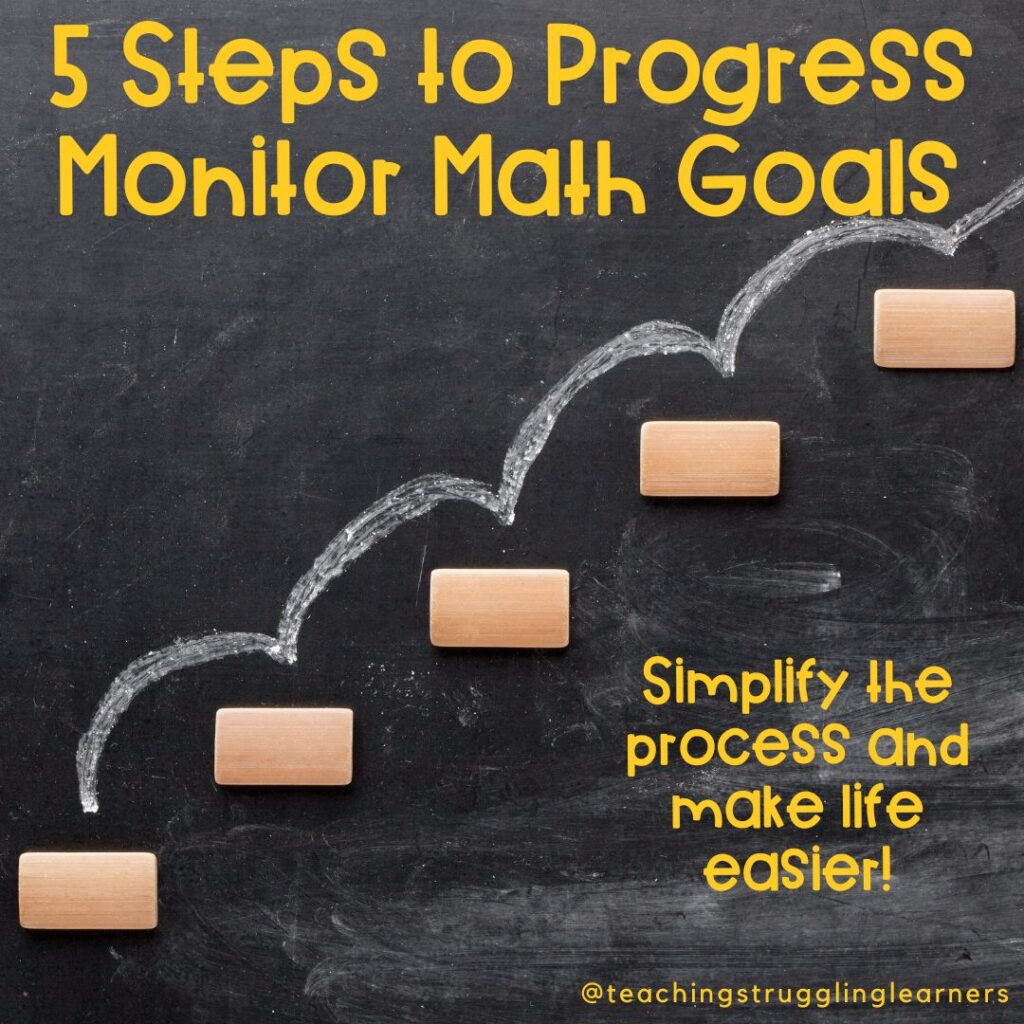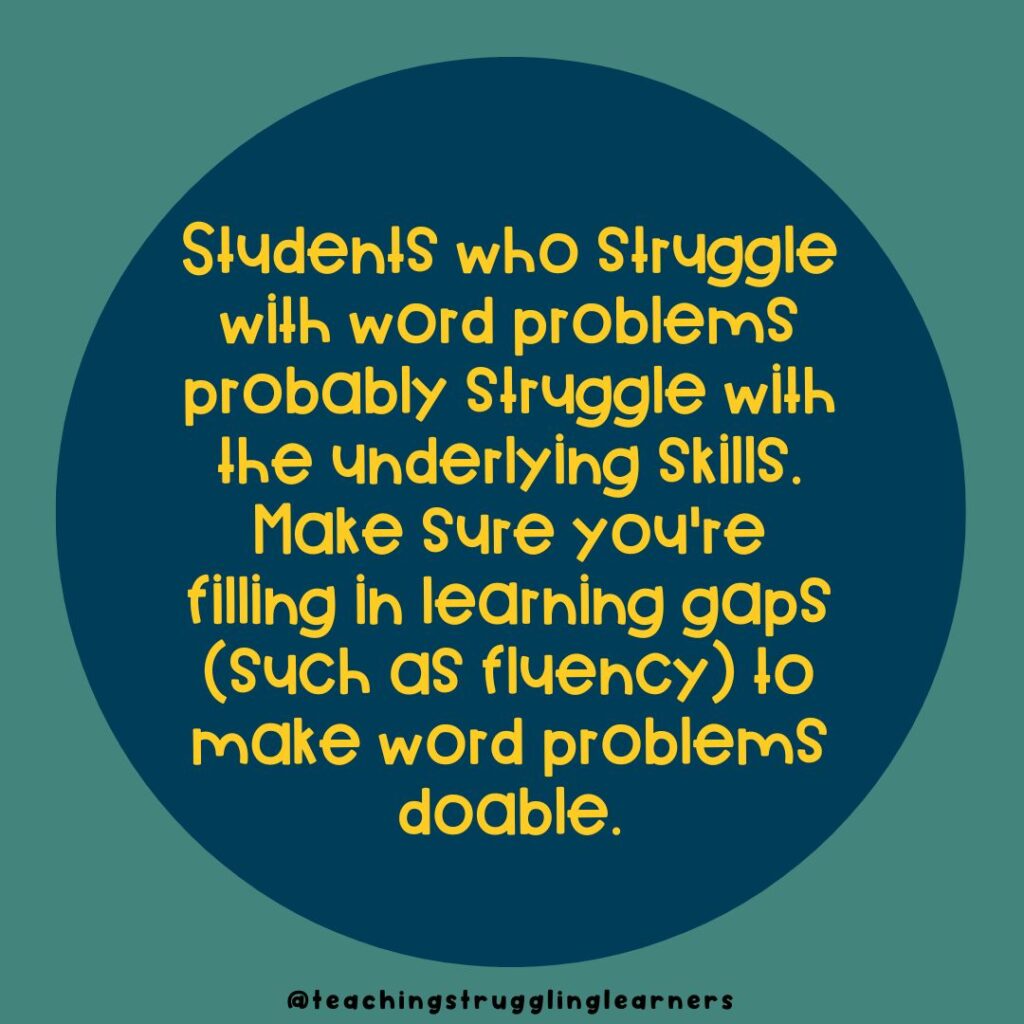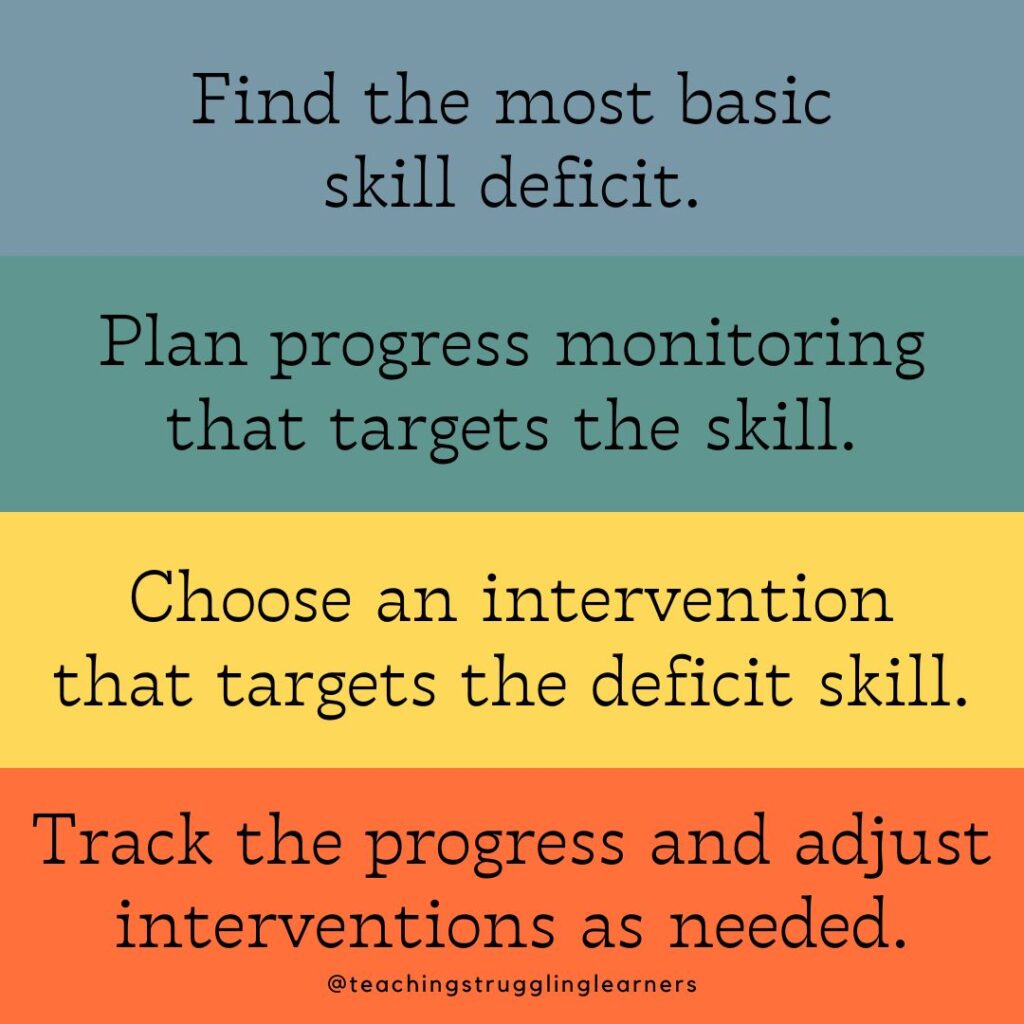5 Steps to Easily Progress Monitor Math Goals

You have MTSS in your school, and there are several students in your class who are struggling in reading. They are receiving the interventions that they need to make progress. But you have noticed that several of your students are also struggling in math. Yes, you know that you should provide support in math, but the thought of progress monitor math goals seems daunting….even though you are already doing this for several of your students in reading.
How do you get started with and easily maintain (or at least try to) progress monitoring math goals? That’s what we will talk about today, so stick around!
There are many schools out there which have been implementing MTSS for reading for a long time. The reality is that there has been a huge federal focus (at least in the US) on reading scores. There is a lot more money tied up in reading programs and interventions than there is in math. That is why MTSS and progress monitoring reading goals is much more prevalent. But that doesn’t mean that MTSS is only for reading.
The fact is that students struggling with math can benefit greatly from the same system, when it is implemented appropriately. For the record, behaviors can also be supported through this exact same system, though there are very few schools out there ready to get started.
The first things that we have to do is identify struggling students AND the most basic skill deficit. This skill deficit is what is impacting their academic performance.
With math progress monitoring, most teachers and schools want to focus on word problems. They believe that by improving how students perform on word problems, then their overall math skills will have improved.
The fact is that word problems are like reading comprehension. All the other skills build up so that word problems can be applied. Students have to have basic numeracy skills, be able to add and subtract, multiply and divide, understand fractions or whatever else the word problem is calling for before we can add in a bunch of words for students to read and comprehend to answer the math problem.

Word problems are basically the culmination or application of the foundational math skills. Students struggling with basic addition and subtraction will struggle to answer basic addition word problems.
Check the more basic or prerequisite skills getting in the way of answering the problems correctly. Often times, it boils down to struggles with math fact fluency, or understanding place value or fractions. All of these skills can be improved upon, once we have identified what the basic skill is that is lacking.
Use universal screeners and other formative assessments to identify the students needing help, and what skills need focus. Some assessments can also give you your baseline data. Now you’re able to really tell how much of an impact your interventions have had.

Determine how quickly the student can or should master a skill or a piece of the skill. Then create a reasonable goal for the student to work toward. For example, a reasonable goal for a student could be that the student will be able to answer 30 addition problems within 20 in 1 minute.
Obviously, the goal depends on what the student needs to work on and how quickly the student retains information when intensely practiced. Take into account whether the student has test or timed text anxiety. Students who freeze up during timed assignments probably won’t do well with timed tests. Instead, expect the student to be able to complete a percentage of problems accurately. Another option could be to give the student more time or fewer problems. The goal is still that their fluency still increases to a more acceptable level.
It’s important to ensure that the goal that is created is geared toward the skill the student is struggling with. I have seen some goals created for students who were struggling with fact fluency, but the goal was to be able to answer word problems with that skill. That goal would have assessed a skill more advanced than where they were actually deficient. Continuing to make the student work at a higher level than they are struggling will just continue to frustrate the student, and won’t make the amount of progress which could be accomplished if the goal were focused on the correct skill deficit.
Once the goal has been established, we need to identify what will be used to actually progress monitor math goals.
it is important that the assessments be quick, no more than 3 to 5 minutes, and actually address the goal not part of it or a more advanced skill. Keeping the assessment consistent in look, number of problems, and when it is administered helps to make the data more reliable. Consistency, whether it is weekly or biweekly is important to assess the progress made and the effectiveness of the intervention.
If you’re looking for math progress monitoring materials, check out my math progress monitoring bundle. It is a growing bundle which currently includes addition and multiplication fact fluency, as well as number identification, as well as practice activities which work great in small groups or as extra practice to send home. I’ll be adding a lot more to the bundle over the next several months, so now’s the time to check it out! I’ll put the link in the show notes to make life easy.
Identifying the intervention to use is the next step.
The same intervention should be implemented over the course of the time frame. That way, the assessments can tell us whether it worked or not and hopefully so that the student can make the optimal amount of progress possible. I will say, for math fact fluency, just doing mad minutes daily is not an intervention. Students need to be retaught skills. They need to be provided with manipulatives and lessons to help the students understand the underlying concepts. The students can then practice using what they learned. With fluency, the idea is that the students master the skill and can quickly answer problems. Practicing this with manipulatives or lessons which teach students how to do mental math can help students improve greatly.
Finally, collect all the materials that will be used for the 6 to 9 week time frame. Then, get them ready to go.
If you have the weekly assessments prepped, it is much less likely that you’ll miss a week. Chances are at some point the copier isn’t going to work, or we’ll be asked to sub for another teacher. Also, it is much easier to stick to the chosen intervention when you have everything prepared and don’t leave it to figuring out the day of.
Getting all your materials together includes preparing how you will collect data numbers so that you can report it later. If you’re anything like me, you’ll get in a session and put the data info on a sticky note… Then 4 weeks later you’re regretting it because those sticky notes get lost, oh so easily in the moment.
Need some data collection sheets? Check out my freebie: 5 Steps to Getting Started with Progress Monitoring. It includes some data sheets that have worked well for me in the past.
Here’s a bonus suggestion for you. Make a system for progress monitoring and intervention materials and plans to use with another group of students. Let’s face it, you’ll probably have another group of students who need to work on that skill later. So make your life easier and save the hard work you’ve done to use again in the future. Keep a record of the goals and outcomes used to get even better at making reasonable goals for your students.
Looking for more help to get started with progress monitoring math goals, or goals in general? Check out my 5 Steps to Getting Started with Progress Monitoring Freebie. You can also find out more information in the blog post: 5 Steps to Begin Effective Progress Monitoring.
